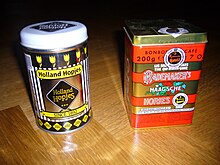Hopje
A Hopje is a candy with a light coffee and caramel taste ; a Dutch specialty made from sugar, cream, coffee and butter that has been around since the end of the 18th century.
Origin and name
The candy is named after Baron Hendrik Hop (1723–1808), a Dutch envoy in Brussels. When the French took Brussels in 1792, the baron was called back to The Hague , where he lived above the pastry shop of the Van Haaren and Nieuwerkerk an der Langen Voorhout 92 until 1801 .
The baron was "addicted" to coffee . One evening he left his mug on the stove with the rest of the coffee, sugar and cream. The following morning he saw that the mixture had turned into a coffee caramel. Hop tasted it and found the lump very tasty. A short time later, when his doctor asked him not to drink any more coffee, he asked his apartment neighbor, the baker and confectioner Theodorus von Haaren, whether he could make this kind of candy. This is how the recipe for these special candies came about. The Nieuwerkerk family dated its creation to 1793; the historian MR van der Krogt, initiator of the Dutch Hopjes Museum names the year 1792. The baron's sweets quickly became known as "the sweets of Baron Hop" and in 1880 they were named "Haagsche Hopjes".
export
The Nieuwerkerk family's confectionery gained fame far abroad. They exported Hopjes to Belgium, England, Germany, British India , Denmark and Russia. Princely houses across Europe and the tsars in Saint Petersburg were among their customers. For the Hopjes that were delivered to the Dutch colony of the Dutch East Indies (later Indonesia ), special boxes have been made since 1875.
Tea room
The Hopjes were copied by JP Rademaker - another confectioner from The Hague - who announced that he was the only one who made the real Hopjes. Rademaker was the first to wrap the sweets in paper. By 1900 there were around 60 companies making Hopjes. In the middle of the 20th century, the Nieuwerkerk company bought the house at number 94 and, in addition to the candy shop, also ran a tea and ice cream parlor there; a new concept in The Hague that became very successful. More and more tea salons quickly appeared, such as Fa. Krul am Noordeinde and Fa. Lensvelt Nicola on Toernooiveld.
Post-war years
Because the Nieuwerkerk family did not make any deliveries to the German administrative bodies or the Wehrmacht during the Second World War , it became difficult to get the ingredients. Nevertheless, in 1943 she celebrated the company's 150th anniversary by hanging the Dutch flag. The Nieuwerkerk family lost everything when the Bezuidenhout district of Hague was bombed. Gerard Nieuwerkerk died in 1948, his wife in 1951, and the shares were taken over by another company, Rademaker from Rotterdam .
In 1971 Rademaker was taken over by the royal company Droste (manufacturer of high quality cocoa and chocolate products) and in 1986 by Dutch Coca & Chocolate Holding BV from Haarlem. In 1999 the “Rademaker Hopjes” brand came into the hands of RBV Leaf (operator of Corbion since 1990 ). The well-known red, square tin cans have been replaced by the white round cans. Since 2007 red tin cans have been produced again.
Trivia
- Hopjes have a somewhat elegant appearance, especially because they are individually wrapped in printed paper; something that was not common back then.
- Since 1998 the "Museum for the Haagsche Hopje" ("Museum voor het Haagsche Hopje") has been closed. It was located at Oude Molstraat 30d, 2513 BB, The Hague. In today's ice cream parlor, only a tenth of the cans are left in the showcase.
- Nieuwerkerk and the Rademaker company in The Hague have litigated for many years. Rademaker advertised that he made the real Hopjes. When the Rotterdam Rademaker Nieuwerkerk took over in 1949, the fighting between the two Rademakers from The Hague and Rotterdam continued for 40 years. In 1989 the commission for advertising decided that the company Rademaker in The Hague was no longer allowed to advertise with the slogan “only real” ('enige real') and that the name of the company always had to be mentioned; so z. B. "the only real Rademaker's Hopjes" or "only real Krul Hopjes".
- Haagse Hopjes Transvaal is the name of a foundation that lends toys to the youth of the Transvaal district in The Hague, but has nothing to do with the Hopjes other than the name.
Individual evidence
- ↑ Review by MR van der Krogt: Hopjes-Een baron in koffie , ISBN 90-74355-01-3, 1992 ( Memento of the original from May 14, 2010 in the Internet Archive ) Info: The archive link was inserted automatically and has not yet been checked. Please check the original and archive link according to the instructions and then remove this notice.

